![[VIDEO] Ultrasound-Guided Injection for Trigger Finger](https://drjordijimenez.com/imagen/100/100/Imagenes/infiltracion-ecoguidada-dedo-resorte-drjordijimenez.jpg)
- Home /
- EXERCISES /
- CERVICAL SPINE EXERCISES /
- EXERCISES FOR THORACIC OUTLET SYNDROME
EXERCISES FOR THORACIC OUTLET SYNDROME
Stretching and strengthening exercises for Thoracic Outlet Syndrome
Neurogenic thoracic outlet syndrome is a condition in which the brachial plexus nerves are compressed at some point from their exit at the cervical level to their arrival at the armpit. This compression, which in most cases is dynamic, is aggravated by sustained abnormal postures of the cervical spine, scapula, and shoulders, causing symptoms such as neck pain, shoulder pain, numbness, tingling, and weakness in the arm, forearm, or hand.
The starting point of conservative treatment is postural correction of those abnormal postures that can perpetuate dynamic compression of the brachial plexus, such as forward head position, anterior shoulder position, or excessive thoracic kyphosis.
To achieve this postural improvement, we need to relax the muscles that are shortened, contracted, and painful (by stretching) and then strengthen the muscles that are inhibited (by performing strengthening exercises).
After stretching each shortened muscle group and achieving a significant improvement in muscle length and pain, we will begin muscle strengthening exercises that will allow us to correct posture and avoid dynamic compression of the brachial plexus along its path.
The following stretches are focused on releasing tension and lengthening the scalene and pectoralis minor muscles, muscles directly involved in the dynamic compression of the brachial plexus as it passes through the interscalene and infraclavicular spaces, respectively.
The exercises are aimed at correcting the forward head position, improving excessive thoracic kyphosis, and returning the shoulders and scapula to an optimal functional position.
Pectoralis minor stretching exercise
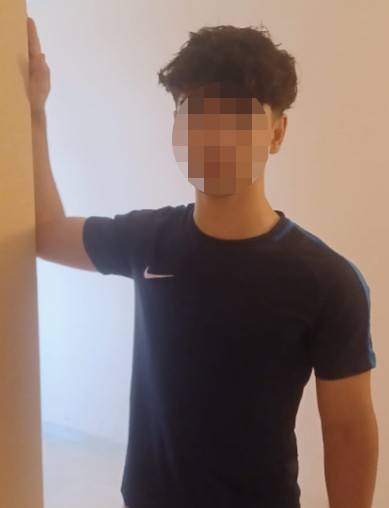
Figure 1: Unilateral Corner Stretch
Stand in front of an open door or corner. Place your elbow at 90° at shoulder height, with your forearm resting on the wall frame (Figure 1). Lean forward, stretching the pectoralis minor on that side. Notice the tightness.
When starting the stretch, it is crucial to avoid pain. You should stretch only until you feel tension in the muscle and tendons, and then hold that position for a while until the tension decreases. With practice, you can extend the length of the stretch, but you should never feel pain.
Goals:
- Pectoralis minor muscle lengthening.
- Improve forward shoulder posture.
- Relieve shoulder pain.
- Improve shoulder joint balance.
- Prevent pectoralis minor syndrome.
Passive stretching exercise for the pectoralis minor and dorsal spine
Passive pectoral stretch, lying supine (face up). Lie on your back with your feet flat on the floor and place a pool roller under your spine (Figure 2). Extend your arms outstretched, resting on the floor. Stay for a while (minimum 15 minutes). Breathe freely. You will gradually feel the stretch in your lats.
When you begin stretching, it is crucial to avoid pain. You should stretch only until you feel tension in the muscle and tendons, and then hold that position for a while until the tension decreases. With practice, you can extend the holding time, but you should never feel pain.
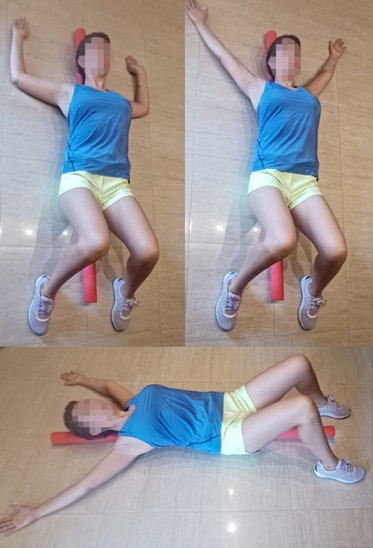
Figure 2
Scalene stretching exercise
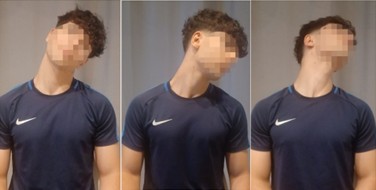
Figure 3 Figure 4 Figure 5
Gaze forward. Neutral cervical position. Perform lateral flexion (ear tries to touch the shoulder on the same side, figure 3), followed by lateral rotation (turn the neck to the same side, figure 4). Finally, raise the neck (as if trying to reach something on the ceiling behind us with your gaze, figure 5). You will notice tension. Do the same exercise on the other side.
When starting the stretches, it is crucial to avoid pain. You should stretch only until you feel tension in the muscle and tendons, and then hold that position for a while until the tension decreases. With practice, you can extend the length of time you hold it, but you should never feel pain.
Goals:
- Postural improvement.
- Reduces neck stiffness.
- Relieves shoulder and neck pain.
- Prevents Thoracic Outlet Syndrome by reducing dynamic compression.
Postural correction exercises
1.-Double chin exercise
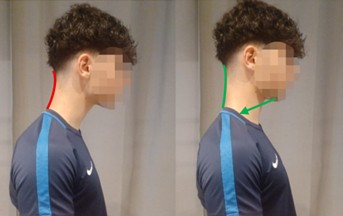
Sit in a chair. Gaze forward. Try to pull your mastoid (the palpable bone behind your ears) back. Straighten your neck and hold this position for 5 seconds. Relax for 5 seconds and repeat.
Perform:
- 5 repetitions
- 3 sets daily
- Progress by gradually increasing the number of sets to 5 sets per day.
Goals:
- Postural correction of a forward neck.
- Extensor muscle stretching.
- Strengthening of deep cervical flexor muscles.
- Pain relief.
- Improved cervical stability.
- Prevention of Thoracic Outlet Syndrome by reducing dynamic compression.
2.- Scapular stabilization exercise: Scapular depression and adduction
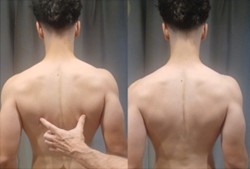
Figure 6 Figure 7
We draw the scapulae downward (scapular depression) and try to bring the lower tip of the scapula toward the spine (scapular adduction). This last movement should be firm but smooth (Figure 6). If we forcefully bring both scapulae together, we overload the rhomboids and upper trapezius (Figure 7). With scapular depression and adduction, we correct the excessive dorsal curvature (dorsal kyphosis). We bring the sternum anteriorly (as if sticking out our chest). We hold the position for 5 seconds.
Perform:
- 10 repetitions
- 3 sets daily
- Progress by gradually increasing the number of sets up to 5 sets per day.
Goals:
- Postural correction of anteriorized shoulders and thoracic kyphosis.
- Muscle relaxation of the upper trapezius and levator scapulae.
- Improve cervical muscle tension.
- Prevention of Thoracic Outlet Syndrome by reducing dynamic compression.
3.-Combination of double chin, depression and scapular adduction exercises
Once we have mastered the performance of both exercises and can easily perform 25 repetitions of both, we combine them and perform them sequentially.
4.-Isometric scapular stabilization exercises
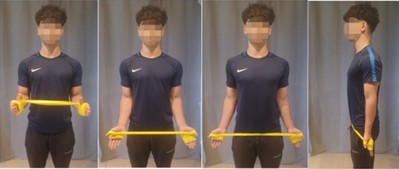
Figure 8 Figure 9 Figure 10 Figure 11
We use elastic bands to create resistance. The bands are color-coded based on their resistance. We start with low resistance and gradually progress.
Brugger's scapular stabilization exercises are the most important for consolidating cervical and thoracic postural correction of the scapula:
- Start in a neutral position (Figure 8). Place an elastic band around your hands with your elbows close to your body and flexed at 90°. Palms face each other.
- Palms facing upward with wrist extension and progressive elbow extension (Figures 9 and 10).
- Fully extend your arms to hip height, maintaining scapular depression and adduction, and a neutral cervical position (Figure 11).
- Slowly return to the starting position.
Perform:
- 15 repetitions
- 3 sets daily
- Progress by progressively increasing the number of sets to 5 sets per day.
Goals:
- Postural correction of anterior shoulders, thoracic kyphosis, and a forward neck.
- Improves cervical flexor muscle overload.
- Activation of cervical and scapular extensor muscles.
- Improvement of cervical muscle tension.
- Prevention of Thoracic Outlet Syndrome by reducing dynamic compression.
>> DOWNLOAD THESE EXERCISES FOR NEUROGENIC THORACIC OUTLET SYNDROME HERE:
 Exercises-neurogenic-thoracic-outlet-syndrome-drjordijimenez.PDF <<
Exercises-neurogenic-thoracic-outlet-syndrome-drjordijimenez.PDF <<
>> DOWNLOAD A SPINE EXERCISE COMPLIANCE CALENDAR HERE: spine-compliance-calendar-drjordijimenez.PDF <<
spine-compliance-calendar-drjordijimenez.PDF <<
Book an appointment with Dr. Jordi Jiménez. He will see you at the center of Palma de Mallorca and help you regain your quality of life.
RELATED NEWS
Frequently asked questions about cervical osteoarthritis
What is cervical osteoarthritis or cervical spondylosis? Cervical osteoarthritis, also defined as cervical spondylosis, refers to the set of age-related degenerative changes that occur in the cervical spine. It is a very common condition; in fact, 85...
Do you suffer from neck pain and dizziness?: Frequently Asked Questions about Cervicogenic Vertigo
What is cervicogenic vertigo (CV)? Cervicogenic vertigo (CV) is a feeling of dizziness or instability that is thought to be caused by a problem in the neck. This can involve muscles, nerves, joints, or ligaments in the cervical area. What are the key...
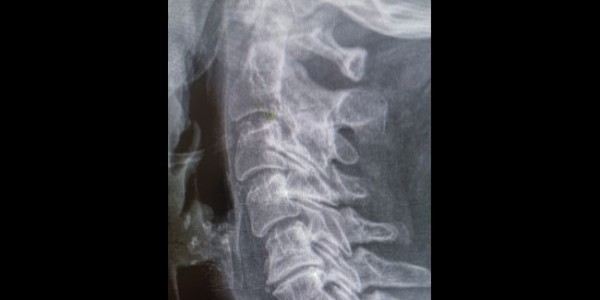


![[VIDEO] Ultrasound-guided infiltration of the lumbar facets](https://drjordijimenez.com/imagen/100/100/imagenes-pagina/sindrome-facetario-lumbar-drjordijimenez (1).jpg)
![[VIDEO] Ultrasound-guided infiltration of the hip joint](https://drjordijimenez.com/imagen/100/100/Imagenes/valgo-dinamico-rodilla-drjordijimenez.jpg)